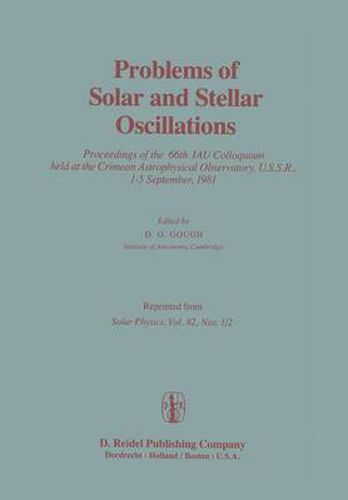Readings Newsletter
Become a Readings Member to make your shopping experience even easier.
Sign in or sign up for free!
You’re not far away from qualifying for FREE standard shipping within Australia
You’ve qualified for FREE standard shipping within Australia
The cart is loading…






This title is printed to order. This book may have been self-published. If so, we cannot guarantee the quality of the content. In the main most books will have gone through the editing process however some may not. We therefore suggest that you be aware of this before ordering this book. If in doubt check either the author or publisher’s details as we are unable to accept any returns unless they are faulty. Please contact us if you have any questions.
D. O. GOUGH Institute of Astronomy. Madingley Road. Cambridge. U. K. IAU Colloquium 66 on ‘Problems of Solar and Stellar Oscillations’ was held at the Crimean Astrophysical Observatory, U. S. S. R. , on 1-5 September, 1981. The principal purpose of the colloquium was to study the low-amplitude oscillations of the Sun and, to a lesser extent, to consider similar oscillations of other stars. Much of the emphasis of the discussions was on the diagnostic value of the oscilla tions. In the last few years we have become aware that the frequencies of the five-minute modes of high degree, which constitute the major component of the oscillations discovered twenty years ago by Evans and Michaud, can be used to put quite tight bounds on the stratification of the solar convection zone. These permit a calibration of solar models computed from so-called standard evolution theory. Modes of low degree penetrate beneath the convection zone to the core of the Sun, and can in principle test the evolution theory. Therefore there was considerable interest in the reports of the latest observations of such modes. Broadly speaking, those observations confirm the cali bration by the high-degree modes, but there remain some systematic discrepancies that demand some revision of the theory. Besides the gross aspects of evolution theory, there are also more intricate details to be understood.
$9.00 standard shipping within Australia
FREE standard shipping within Australia for orders over $100.00
Express & International shipping calculated at checkout
This title is printed to order. This book may have been self-published. If so, we cannot guarantee the quality of the content. In the main most books will have gone through the editing process however some may not. We therefore suggest that you be aware of this before ordering this book. If in doubt check either the author or publisher’s details as we are unable to accept any returns unless they are faulty. Please contact us if you have any questions.
D. O. GOUGH Institute of Astronomy. Madingley Road. Cambridge. U. K. IAU Colloquium 66 on ‘Problems of Solar and Stellar Oscillations’ was held at the Crimean Astrophysical Observatory, U. S. S. R. , on 1-5 September, 1981. The principal purpose of the colloquium was to study the low-amplitude oscillations of the Sun and, to a lesser extent, to consider similar oscillations of other stars. Much of the emphasis of the discussions was on the diagnostic value of the oscilla tions. In the last few years we have become aware that the frequencies of the five-minute modes of high degree, which constitute the major component of the oscillations discovered twenty years ago by Evans and Michaud, can be used to put quite tight bounds on the stratification of the solar convection zone. These permit a calibration of solar models computed from so-called standard evolution theory. Modes of low degree penetrate beneath the convection zone to the core of the Sun, and can in principle test the evolution theory. Therefore there was considerable interest in the reports of the latest observations of such modes. Broadly speaking, those observations confirm the cali bration by the high-degree modes, but there remain some systematic discrepancies that demand some revision of the theory. Besides the gross aspects of evolution theory, there are also more intricate details to be understood.